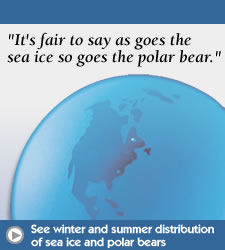Polar bears and bowhead whales: surprising connections
Photos courtesy Torsten Bentzen.
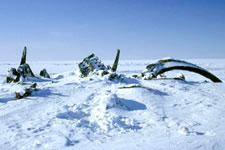
A pile of bowhead whale bones is stacked along the Beaufort Sea coast. Polar bears in this region regularly gather at whale-butchering sites and bone piles to feed on scraps.
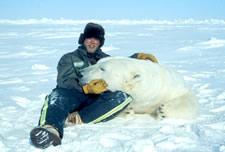
Bentzen holds the head of a sedated polar bear. He is presently the only graduate student in the UAF biology and wildlife program whose primary focus is polar bears.
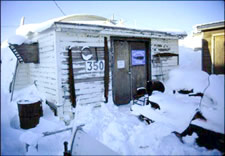
Bentzen did some of his laboratory analyses in a small research facility on the Beaufort Sea coast.
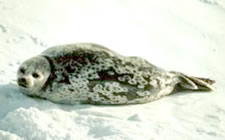
The ringed seal is the most numerous and widely distributed marine mammal in the Arctic.
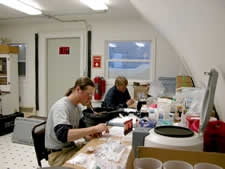
Bentzen prepares polar bear blood samples for analysis as part of his research project. Bentzen earned a bachelor of science in biology and wildlife from UAF in 2002 and hopes to graduate with a master of science degree in biology and wildlife in December 2005.
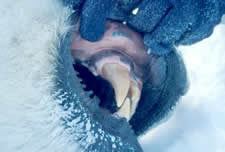
The vestigial premolar, seen as a very small whitish dot just behind the upper canine, forms annual layers like tree rings. A polar bear’s age can be determined by examining a thin slice of this tooth and counting the layers.
By Marie Gilbert, Institute of Arctic Biology
July 2005
A polar bear circled the four biologists as they checked out the house-sized pile of whale bones at Point Barrow, Alaska--the northernmost point of the United States.
Two snowmobiles, whining nearby, were ready to take the scientists back to the city of Barrow. A March sun was setting red against the sea ice, the northern lights began swirling green across the sky and a near-perfect arctic evening was coming to a close when one of the two snowmobiles died.
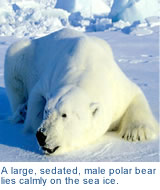 Although the snowmobile couldn't be restarted and the four men piled uncomfortably
onto a single sled for the ride back to Barrow, University of Alaska Fairbanks biology and wildlife graduate student Torsten Bentzen considered his first polar bear sighting relatively
uneventful. By getting a sample of the whale flesh still clinging to the bones Bentzen
could further his research on the diet of Beaufort Sea polar bears and add to scientific
understanding of how the bears are coping in a rapidly changing Arctic.
Although the snowmobile couldn't be restarted and the four men piled uncomfortably
onto a single sled for the ride back to Barrow, University of Alaska Fairbanks biology and wildlife graduate student Torsten Bentzen considered his first polar bear sighting relatively
uneventful. By getting a sample of the whale flesh still clinging to the bones Bentzen
could further his research on the diet of Beaufort Sea polar bears and add to scientific
understanding of how the bears are coping in a rapidly changing Arctic.
"Years of observation tell us that a polar bear's diet is primarily comprised of ringed seals," Bentzen said. Scientists and hunters who saw the bears feeding on ringed seals and saw discarded remains of ringed and bearded seals on the sea ice assumed that's what the bears were eating. Bentzen's research took a more finely scaled approach by analyzing blood samples from more than 150 polar bears for the distinctive chemical signatures of the bears' likely food--ringed seals and bearded seals, and possibly bowhead whales.
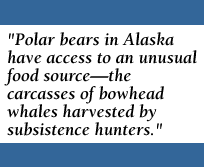 "Polar bears in Alaska have access to an unusual food source--the carcasses of bowhead
whales harvested by subsistence hunters," Bentzen said. Hunters in Canada and Greenland
do not harvest bowheads.
"Polar bears in Alaska have access to an unusual food source--the carcasses of bowhead
whales harvested by subsistence hunters," Bentzen said. Hunters in Canada and Greenland
do not harvest bowheads.
"It had been more than five years since any Beaufort Sea bears were evaluated. That project included fewer than 30 bears and didn't cover the entire Beaufort Sea," said Steve Amstrup, a polar bear biologist with the U.S. Geological Survey and Bentzen's research collaborator. Thirty bears is not a large enough sample to draw valid conclusions about the bears' general health or diet. "The bears Torsten sampled are more broadly representative of the entire Beaufort Sea bear population than anything that has been done before," Amstrup said.
Polar bear biologists from Alaska and Canada stress the importance of establishing baseline information about what bears are eating and at what levels chemical pollutants are accumulating in their tissues. Such information is critical for making year-to-year comparisons of bear health as Beaufort Sea resource exploration and development increase and as the potential for year-round shipping through the Canadian archipelago nears reality.
"If the current sea-ice prognosis is correct, shipping lanes will eventually go right through the Canadian archipelago and by then the species we're concerned about now may not even exist," said Andrew Derocher, polar bear biologist from the University of Alberta, Canada. In the recent Arctic Climate Impact Assessment report, a team of international scientists predicts shipping through the Northwest Passage could become routine as early as 2050.
Polar bear habitat is constantly moving and where bears find seals is where biologists find bears. The best places to find seals are in shallow, near-shore waters where openings in the sea ice, called leads, provide breathing holes and where arctic cod, saffron cod, shrimp and other crustaceans are plentiful.
"Once we find good habitat, we fly in a helicopter about 100 feet above the ground and follow the tracks," Bentzen said. "It takes time to recognize fresh polar bear tracks from normal deformations in the snow and ice. It's a pattern in the snow that's unusual, a trail, a track--a line in the snow that's distinctive."
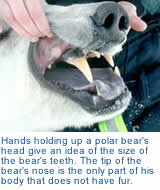 "The best time to capture bears is March and April," Bentzen said. The females are
just leaving the dens with their cubs and are walking the sea ice hunting for ringed
seals, which are giving birth about the same time.
"The best time to capture bears is March and April," Bentzen said. The females are
just leaving the dens with their cubs and are walking the sea ice hunting for ringed
seals, which are giving birth about the same time.
Once a bear is spotted the pilot maneuvers the helicopter so one of the biologists can dart the bear with a tranquilizer. It takes up to 15 minutes for a bear to be sedated enough to be approached safely and it stays sedated for about 45 minutes to an hour--barely enough time for Bentzen to make measurements and collect samples.
"It can take us about an hour to weigh the bear and measure its length, girth and skull size, take blood and fat samples and remove a tooth," Bentzen said. To estimate the age of a polar bear, researchers extract a very small, vestigial premolar which forms annual layers like tree rings. Age can be determined by examining a thin slice of tooth back in the laboratory and counting the layers.
Laboratory analyses yield surprises
Using a technique called stable isotope analysis, Bentzen determines the relative percentages of whale and seal in the bears' diet. If polar bears were feeding almost exclusively on seals, as most scientists expected, Bentzen's blood analyses would have shown strong stable-isotope signatures for ringed and bearded seals and little if any whale.
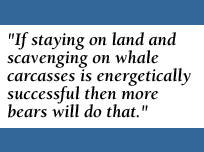 What Bentzen saw was surprising. His preliminary results showed that bowhead whales
may make up more than 10 percent of a Beaufort Sea polar bear's diet. Biologists knew
bears fed on the occasional bowhead carcass, but assumed the whales were an insignificant
portion of their diet. Bentzen wondered if there could be enough whale carcasses to
account for what his analyses was telling him.
What Bentzen saw was surprising. His preliminary results showed that bowhead whales
may make up more than 10 percent of a Beaufort Sea polar bear's diet. Biologists knew
bears fed on the occasional bowhead carcass, but assumed the whales were an insignificant
portion of their diet. Bentzen wondered if there could be enough whale carcasses to
account for what his analyses was telling him.
"There are probably over 1,500 polar bears in the Beaufort Sea," said Bentzen, "so I estimated how many whales it takes to make up 10 percent of the diet of 1,500 polar bears and came up with less than 10 whales--definitely a doable number of whales to be available to polar bears" in that region.
"It's a pretty substantial finding," Derocher said. "It may have ramifications for how well the bears are doing. If staying on land and scavenging on whale carcasses is energetically successful then more bears will do that," Derocher said. "The downside is that it puts bears close to major oil and gas development and if you had a blowout then a large proportion of the population would be at risk."
Persistent organic pollutants
Bentzen also analyzed fat samples from polar bears for man-made chemical compounds called organochlorines, such as DDT and PCBs, which are considered persistent organic pollutants and accumulate in fat. Polar bears are predatory carnivores that feed almost exclusively at the top of the food chain. Many of the chemical pollutants consumed by animals the bears eat are concentrated in the bears' tissues. Many organochlorines are rarely used--though still produced--in the United States because of their toxic effects and environmental persistence, but continue to be used in other countries. Elevated levels of organochlorines have been associated with neurological, reproductive and immunological changes in laboratory animals.
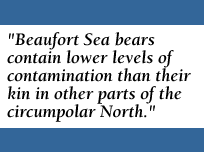 Bentzen's organochlorine analyses show that Beaufort Sea bears contain lower levels
of contamination than their circumpolar kin. Bentzen said he thinks the bears can
thank the whales, in part. By feeding on bowheads, which eat zooplankton, the bears
are eating lower on the food chain and ingesting fewer contaminants.
Bentzen's organochlorine analyses show that Beaufort Sea bears contain lower levels
of contamination than their circumpolar kin. Bentzen said he thinks the bears can
thank the whales, in part. By feeding on bowheads, which eat zooplankton, the bears
are eating lower on the food chain and ingesting fewer contaminants.
Climate changes affect bears and bowheads
While the bowhead's contribution to the health of Beaufort Sea bears appears beneficial, rapid climate warming in the Arctic could render the benefit short-lived.
"What happens if sea ice patterns continue to change and the whales start moving farther offshore and hunters can't access whales?" Derocher conjectured. "What happens to the populations of polar bears that have developed patterns of feeding on bowhead carcasses? Now we've got 200, 300, 400 polar bears lying around and in close proximity to people."
Can the bears go back to eating mostly seals and the occasional beached whale? It doesn't appear likely if the predictions about arctic sea ice are correct.
According to the ACIA report, in the last few decades average Arctic temperatures have risen at nearly twice the rate as the rest of the world. In Alaska and western Canada, average winter temperatures have increased by as much as 4.8-6.4 degrees Fahrenheit (3-4 degrees Celsius) over the past 60 years. The resulting shrinking sea ice is likely to have devastating effects on the polar bears' primary food--ice-dependent seals. Ringed and bearded seals are "particularly vulnerable to the observed and projected reductions in arctic sea ice because they give birth to and nurse their pups on the ice and use it as a resting platform. Adapting to life on land in the absence of summer sea ice seems highly unlikely for these species," according to the ACIA report.
While polar bear populations depleted by over-hunting have rebounded and, since the mid-1970s, have coexisted with oil development on Alaska's North Slope, they are "unlikely to survive as a species if there is an almost complete loss of summer sea-ice cover, which is projected to occur before the end of this century by some climate models," according to the ACIA report.
"It's fair to say as goes the sea ice so goes the polar bear," said Amstrup.
Bentzen is a bit more optimistic about the shrinking sea ice. "Polar bears may be more resilient and adaptable than we give them credit for," he said.
For more information, please contact:
- Marie Gilbert, publications and information coordinator, UAF Institute of Arctic Biology, marie.gilbert@uaf.edu or (907) 474-7412.
Useful Links:
- Arctic Climate Impact Assessment
- Alaska Department of Fish and Game Wildlife Notebook
- Alaska Science Forum
- Polar Bears Alive
- Polar Bears International



